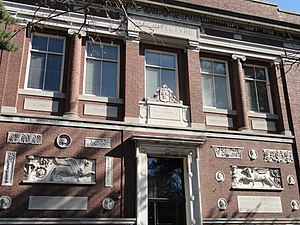
Graduate School of Architecture, Planning and Preservation (GSAPP) is the architecture school of Columbia University, a private research university in New York City. It is regarded as an important and prestigious architecture school. It is also home to the Masters of Science program in Advanced Architectural Design, Historic Preservation, Real Estate Development, Urban Design, and Urban Planning.
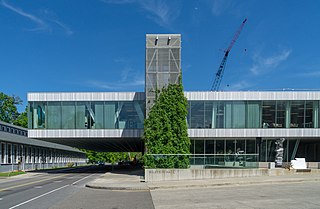
The College of Architecture, Art, and Planning (AAP) is the school of architecture at Cornell University in Ithaca, New York. It offers 20 undergraduate and graduate degrees in five departments: architecture, art, urban planning, real estate, and design technology. Aside from its main campus in Ithaca, AAP offers programs in Rome, Italy and in New York City, New York.
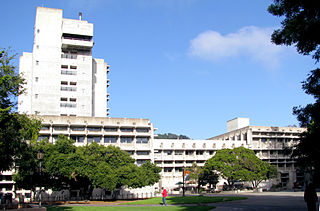
The College of Environmental Design, also known as the Berkeley CED, or simply CED, is one of fifteen schools and colleges at the University of California, Berkeley. The school is located in Bauer Wurster Hall on the southeast corner of the main UC Berkeley campus. It is composed of three departments: the Department of Architecture, the Department of City and Regional Planning, and the Department of Landscape Architecture and Environmental Planning.

The A. Alfred Taubman College of Architecture and Urban Planning, also known as Taubman College, is the school of architecture and urban planning and one of the nineteen schools of the University of Michigan located in Ann Arbor, Michigan.

CEPT University, formerly the Centre for Environmental Planning and Technology, is an academic institution located near University Area in Ahmedabad, India offering undergraduate, postgraduate and doctoral programmes in areas of natural and developed environment of human society and related disciplines.

The University of Cincinnati College of Design, Architecture, Art, and Planning (DAAP) is an arts and architecture college of the University of Cincinnati in Cincinnati, Ohio. It was initially established as the School of Applied Art in 1926.
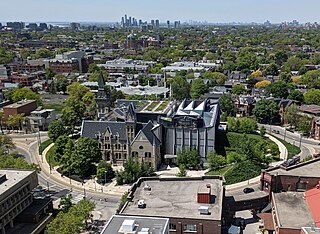
The John H. Daniels Faculty of Architecture, Landscape, and Design is an academic division at the University of Toronto which focuses on architecture, urban design and art. The Faculty was the first school in Canada to offer an architecture program, and it was one of the first in Canada to offer a landscape architecture program. As of July 2021, its dean is Juan Du.

The Tulane University School of Architecture is the architecture school at Tulane University in New Orleans, Louisiana. The school has a student body of approximately 442 students.

The MIT School of Architecture and Planning is one of the five schools of the Massachusetts Institute of Technology in Cambridge, Massachusetts. Founded in 1865 by William Robert Ware, the school offered the first architecture curriculum in the United States and was the first architecture program established within a university. MIT's Department of Architecture has consistently ranked among the top architecture/built environment schools in the world.
Edward Lifson is an American journalist, architecture critic, and academic. He was the Director of Communications for the Pritzker Architecture Prize. He was also a domestic, foreign and war correspondent and bureau chief for NPR National Public Radio; and he created and hosted a radio show in Chicago called "Hello Beautiful!" to explore and tell stories of urban issues, architecture and design. Lifson is an Adjunct Instructor in the Media Center at the USC Annenberg School for Communication and Journalism. For NPR, in the U.S. Lifson covered urban affairs, politics, economics, labor and arts and culture. In 1996, he established the National Public Radio Bureau in Berlin, Germany. In Europe, he covered the rebuilding of Berlin as a city and a national capital, European Union, post-Cold War politics, NATO, the launch of the euro, immigration issues, and Central Europe’s transition to democracy and capitalism. As a war correspondent, he reported extensively for NPR from Serbia, Kosovo, Montenegro and Macedonia before and during the war in Kosovo. In addition to Berlin, he has lived for many years in Paris, Florence, Italy and in England. Lifson was the interim Director of the Shanghai-based American Academy in China, an urban design think tank and studio.

The School of Architecture at UNAM is one of the leading schools of architecture and design in Mexico. It offers undergraduate and postgraduate studies in architecture, landscape architecture, urbanism and industrial design.
The Cal Poly Pomona College of Environmental Design is a college part of the California State Polytechnic University, Pomona. The college houses over 1,600 students; making it one of largest environmental design programs in the United States. The college offers bachelor's degrees in five departments, as well as three master's degree programs. It is the only academic unit within the California State University system to be associated with a Pritzker Prize laureate.

The College of Built Environments is the architecture and urban planning school of the University of Washington, a public research university in Seattle, Washington.

The Sam Fox School of Design & Visual Arts is a part of Washington University in St. Louis. The Sam Fox School was founded in 2006 by uniting the academic units of Architecture and Art with the university's Mildred Lane Kemper Art Museum. It is dedicated in honor of donor, former United States Ambassador to Belgium, and owner of Harbour Group Industries, Sam Fox. The school comprises
The USC School of Architecture is the architecture school at the University of Southern California. Located in Los Angeles, California, it is one of the university's twenty-two professional schools, offering both undergraduate and graduate degrees in the fields of architecture, building science, landscape architecture and heritage conservation.
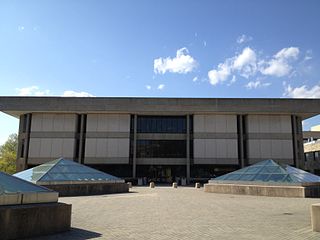
The College of Architecture, Arts, and Design formerly the College of Architecture and Urban Studies at Virginia Tech consists of four schools, including the School of Architecture, which consistently ranks among the best in the country. Headquartered in Blacksburg, Virginia, the college also has sites in Alexandria, Virginia, and Riva San Vitale, Switzerland. Spread out among these three locations, the college consists of nearly 2,200 students, making it one of the largest schools of architecture in the nation.
Cherie Kluesing was an American landscape architect, designer, and educator. She received a Boston Society of Landscape Architects award in 1988 for her restoration plan for Frederick Law Olmsted's Buttonwood Park in New Bedford, Massachusetts. She wrote extensively on land art and landscape architecture, and was known for her advocacy for integrating art works and landscape.
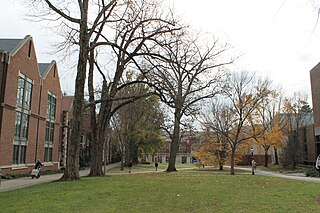
Princeton University School of Architecture is the name of the school of architecture at Princeton University. Founded in 1919, the School is a center for teaching and research in architectural design, history, and theory. The School offers an undergraduate concentration and advanced degrees at the master's and doctoral levels.
Ana Miljački is a historian, theorist, educator and curator of architecture. She is an Associate Professor of Architecture at MIT where she directs the Critical Broadcasting Lab, the Architecture and Urbanism Group and the Master of Architecture Program.
Grace La is a first generation, Korean-American designer, Chair of the Department of Architecture and Professor of Architecture at the Harvard University Graduate School of Design (GSD), and Principal of LA DALLMAN. Co-founded with James Dallman, LA DALLMAN is a design firm recognized for the multidisciplinary integration of architecture, infrastructure, and landscape, with offices in Boston, MA and Milwaukee, WI. La previously served as the Chair of the Harvard GSD's Practice Platform and served as GSD's Director of the Master of Architecture Programs (2014–17).



